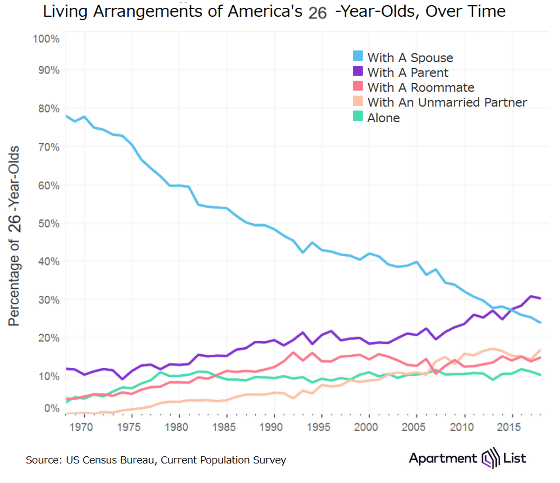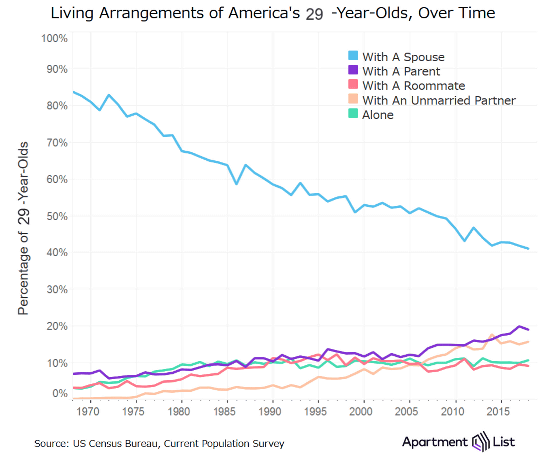Pointed out that the number of young people living with their parents without getting married is increasing significantly in the United States

by
The idea that “young people become independent and leave their parents when they grow up” is deeply rooted, but when analyzing the 50-year data collected by the United States Census Bureau , `` youth living with parents has been more than decades old The fact that it has increased significantly 'became clear.
Reconfiguring The American Household-Rentonomics
https://www.apartmentlist.com/rentonomics/reconfiguring-the-american-household/
Rob Warnock and Igor Popov, analysts at the Apartment List , an online rental brokerage service, pointed out that the American household structure has changed gradually over the decades and has grown and diversified. The research team analyzed 50 years of census data from the United States Census Bureau, and investigated how changes in cultural norms and economic conditions affected household composition.
As a result of this analysis, it has been found that the proportion of young Americans living with spouses has declined significantly and the proportion of living with parents and roommates has increased. The research team has pointed out that “this tendency is particularly strong” is the age group of “26 years old”.
The following image is a graph showing what kind of household a 26-year-old American lives in, with the horizontal axis representing the age and the vertical axis representing the percentage of the total. Light blue is 'people living with spouse', purple is 'people living with parents', red is 'people living with roommates', light orange is 'people living with unmarried partners', green is ' It shows the percentage of people who live alone. Looking at the graph, it seems that nearly 80% of young people were married and lived with their spouses in the 1960s, but since 1970, the number of married and living with spouses has decreased dramatically. In contrast, the number of people living with their partners and roommates has increased, with the proportion of people living with parents in particular exceeding 30% as of 2018, exceeding the proportion of people living with spouses. On the other hand, there are only about 10% of single-person households as of 2018.

Also, nearly 23% live with their parents at age 23 ...

Although the number of people living with their spouses is increasing at the age of 29, it can be seen that nearly 20% live with their parents.

Fifty years ago, 76% of 26-year-old Americans married and lived with their spouses, but as of 2018, only 24% live with their spouses. The research team pointed out that one of the reasons for this change was the decline in the marriage rate. He added that new options such as living with roommates and unmarried partners are becoming more common among young people.
The graph below shows how the youth household composition has changed since 2007, the year before the

According to the research team, the total number of households in the United States increased by 10% from 2007 to 2018, and there are 127.5 million households in 2018. On the other hand, the increase in the number of households living only with relatives is only 7%, and the number of households living with unrelated persons is increasing by 22%. In addition, “living with unrelated people” here includes cases where married couples and nuclear family households live with unrelated persons as roommates in addition to being single. .
In the following graph, which shows the 'increase rate of households living with unrelated partners' in 25 metropolitan areas in the United States, living with unrelated partners is increasing in most urban areas. Has been shown. In cities like Orlando , San Antonio , Denver , San Diego , and Charlotte , the number of households living with unrelated people has more than doubled.

On the other hand, the number of nuclear family households has declined significantly, and the number of nuclear family households in 2018 is about the same as in 1984 when the American population was 27% less. For this reason, the research team pointed out that housing costs have risen prohibitively in many regions, and nuclear family households may not be able to cover housing costs. In many cases, such households are paying for housing due to living with a partner who is not related to them.
The research team expects that the upward trend in housing costs will continue, and the number of nuclear family households will decrease, and the household composition will diversify, such as the number of households living with unrelated people and parents doing. This trend will be reflected in newly built houses, and there is a possibility that the number of houses suitable for home sharing will increase.

Related Posts:
in Note, Posted by log1h_ik







